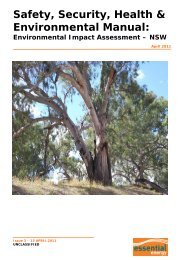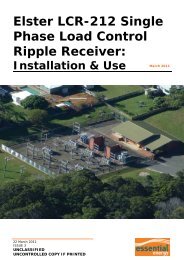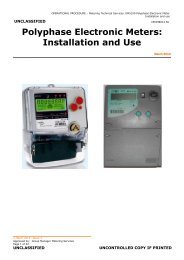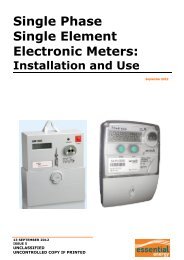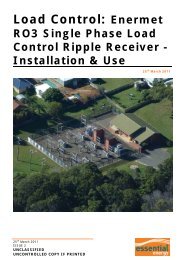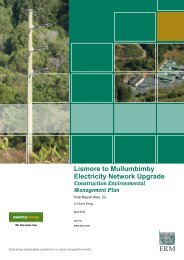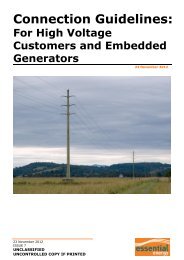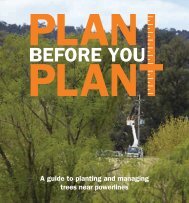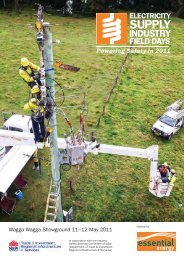Full Version - Essential Energy
Full Version - Essential Energy
Full Version - Essential Energy
Create successful ePaper yourself
Turn your PDF publications into a flip-book with our unique Google optimized e-Paper software.
• Electricity Industry Act 2000 No. 68 (VIC), which was<br />
amended by the <strong>Essential</strong> Services Commission<br />
(Amendment) Act 2004 No. 75, so that certain<br />
prescribed matters, determinations and requirements<br />
have consistent meanings as provided by the<br />
<strong>Essential</strong> Services Commission Act 2001 No. 62<br />
(VIC).<br />
• <strong>Energy</strong> Legislation (Regulatory Reform) Act 2004 No.<br />
25, which amends the Electricity Safety Act 1998 No.<br />
25 (VIC), the Electricity Industry (Residual Provisions)<br />
Act 1993 No. 130 (VIC) and the Electricity Industry<br />
Act 2000 No. 68 and seeks to facilitate the transition<br />
to nationally consistent regulation of energy markets.<br />
Queensland<br />
• Electricity Safety Regulations 2002, which was<br />
amended by the Electrical Safety Amendment<br />
Regulation (No.1) 2005 and inserts new provisions<br />
relating to electrical equipment testing, excavation<br />
and underground electrical services by employers,<br />
self-employed persons or principal contractors and an<br />
extension of the term of approval by up to one year<br />
and renewal of approval.<br />
South Australia<br />
• Australian <strong>Energy</strong> Market Commission Establishment<br />
Act 2004 No. 24 (SA), which established the<br />
Australian <strong>Energy</strong> Market Commission as the entity<br />
responsible for the rule-making and development<br />
of the national energy sector. The act provides for<br />
the appointment of three Commissioners and sets<br />
out the functions and objectives of the Commission<br />
and other matters necessary to establish the<br />
Commission.<br />
• Electricity (General) Regulations 1997 No. 161<br />
(SA), which is amended by the Electricity (General)<br />
Variation Regulations 2004/252 (SA) and requires<br />
certain electrical installations and infrastructure<br />
development to comply with the Australian Standard<br />
or the Australian/New Zealand Standard. The<br />
regulation also amends the standards, codes,<br />
guidelines and other documents relating to aerial<br />
powerlines.<br />
National Electricity Code<br />
A number of amendments were made to the National<br />
Electricity Code that either directly or indirectly affect<br />
Country <strong>Energy</strong>. These include –<br />
• The Victorian, the Australian Capital Territory, New<br />
South Wales and South Australian derogations were<br />
amended to extend the period in which the local<br />
network service provider is to be the responsible<br />
person for metering installations type 5, 6 and 7<br />
until 31 December 2006.<br />
• Tasmania became a participating jurisdiction within<br />
the meaning of the National Electricity Law on 29<br />
May 2005. Provisions were made for this transition<br />
by Tasmania into the National Electricity Market.<br />
• As of 5 May 2005, the reserve trader sunset<br />
provisions under the code were extended until<br />
1 July 2006.<br />
• The defined communications between distribution<br />
and retail companies operating in the national<br />
market were altered and expanded. Protocols and<br />
mechanisms of these communications support<br />
transactions and information requirements of full<br />
retail competition in addition to the existing Market<br />
Settlements and Transfers Systems commenced on<br />
21 April 2005.<br />
• As of 8 April 2005, the code was amended in<br />
respect to the transmission pricing arrangements<br />
for TransGrid and <strong>Energy</strong> Australia.<br />
• As of 17 February 2005, the code was amended to<br />
address inadequate arrangements for management<br />
of power system security and efficient utilisation of<br />
available transmission capacity in the short-term.<br />
• The obligation to provide a mid-year update of the<br />
Statement of Opportunities was removed and the<br />
yearly publication date changed.<br />
• As of 1 July 2005, the roles and functions of NECA<br />
were replaced by the Australian <strong>Energy</strong> Market<br />
Commission and the Australian <strong>Energy</strong> Regulator.<br />
• As of 2 December 2004, generators below a<br />
10MW/40GWhr a year threshold received sitespecified<br />
loss factors provided they meet network<br />
service providers reasonable costs in calculating<br />
these factors.<br />
61<br />
COUNTRY ENERGY ANNUAL REPORT 2004–2005




